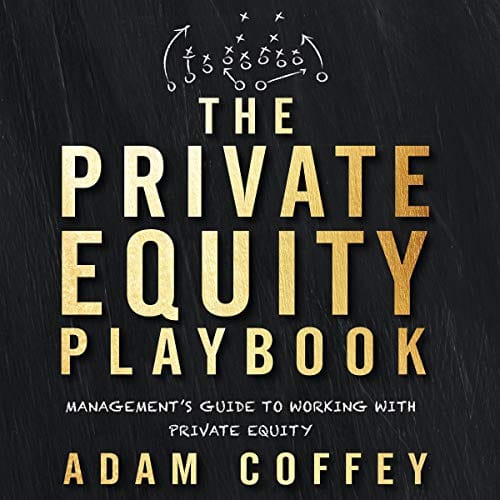The Private Equity Playbook Review

This is Money Management Mentor, a brand new site by Joshua Bevan that's just getting started. Things will be up and running here shortly, but you can subscribe in the meantime if you'd like to stay up to date and receive emails when new content is published!"The Private Equity Playbook" by Adam Coffey is a comprehensive guide for business leaders and private equity (PE) professionals, providing insights into the world of private equity from both a business owner's and an investor's perspective. Here is an in-depth summary:
Introduction:
Private equity has become an influential player in the business world. It represents vast pools of capital seeking investment in promising businesses to generate substantial returns. Adam Coffey, having vast experience in the PE space, shares insights into how PE firms operate, strategies for successful exits, and what business leaders can expect when engaging with private equity.
1. Private Equity 101:
Private equity, at its core, involves investment firms acquiring equity in companies, growing them, and eventually selling them to reap significant returns. This process can last anywhere from 3-7 years. PE firms primarily aim to acquire businesses with potential, inject capital, expertise, and strategic insights, then grow the businesses and exit with a profitable sale.
2. The PE Business Model:
Coffey outlines the primary model that most PE firms adopt:
- Fundraising: PE firms raise capital primarily from institutional investors like pension funds, university endowments, or wealthy individuals.
- Sourcing & Acquiring: They then identify potential acquisition targets, businesses with growth potential that can benefit from an influx of capital and expertise.
- Value Addition: Once acquired, the PE firm works closely with the business, streamlining operations, optimizing performance, and driving growth.
- Exit: After enhancing the business's value, the PE firm seeks a profitable exit, either through a sale to another company, another PE firm, or through a public offering.
3. CEO's Role in a PE-Owned Business:
Coffey emphasizes the CEO's role in a PE-backed company. The CEO needs to align with the PE firm's objectives, ensuring that the company meets growth targets and is prepared for a profitable exit. Regular communication, understanding the PE's expectations, and being data-driven are crucial for a CEO's success in such a setup.
4. Creating Value:
For a PE firm, mere acquisition isn't enough. The real challenge lies in creating value post-acquisition. This involves:
- Operational Improvements: Streamlining operations, cutting inefficiencies, and optimizing processes.
- Strategic Growth: Exploring new markets, expanding product lines, or seeking strategic mergers and acquisitions.
- Talent Management: Hiring the right talent, providing training, and creating a conducive work environment.
5. The Exit:
An exit is the endgame for any PE investment. Coffey discusses various exit strategies:
- Secondary Buyout: Selling to another PE firm.
- Trade Sale: Selling to another company in a similar industry.
- Initial Public Offering (IPO): Taking the company public by listing its shares on a stock exchange.
The exit strategy is often decided based on market conditions, the company's readiness, and the potential returns each option offers.
6. Engaging with Private Equity:
For business owners considering partnering with PE, Coffey offers valuable insights:
- Preparation: Understand your business's worth, clean up financials, and be prepared for due diligence.
- Choosing the Right PE Partner: Not all PE firms are alike. Choose one that aligns with your vision, values, and industry.
- Negotiation: Understand the terms of the deal, especially concerning management's role post-acquisition and the exit timeline.
7. The Future of Private Equity:
PE continues to evolve, and its influence in the business world is undeniable. With increasing capital allocations to this asset class, PE firms are becoming larger and wielding more influence. They are also diversifying, exploring new industries, geographies, and even adopting technological innovations to drive growth in their portfolio companies.
8. Advice for Business Leaders:
Coffey concludes by offering advice to business leaders:
- Be Data-Driven: In a PE-backed environment, data is crucial. Make decisions based on data, not just gut feelings.
- Communication: Maintain open channels with the PE firm, ensuring alignment in objectives and strategies.
- Stay Agile: The business world is dynamic. Adaptability is key to navigating challenges and seizing opportunities.
- Focus on Long-Term Value: While PE often has a defined investment horizon, the focus should always be on creating long-term, sustainable value.
Conclusion:
"The Private Equity Playbook" offers a deep dive into the world of private equity, unraveling its complexities and shedding light on its modus operandi. For business leaders, it's an invaluable guide to understanding PE, preparing for engagement, and driving success in a PE-backed environment. For PE professionals, it reinforces best practices and emphasizes the importance of creating real, sustainable value. In a world where capital is abundant but returns are challenging, private equity stands out as a potent force, and understanding its nuances is vital for any business leader.

